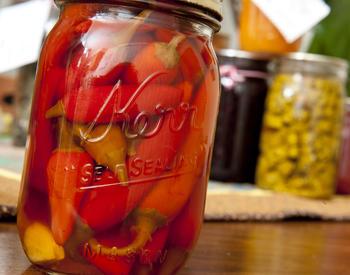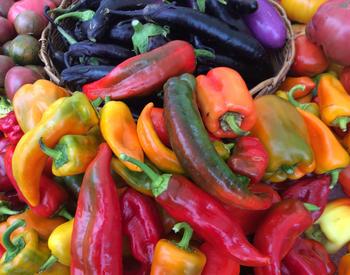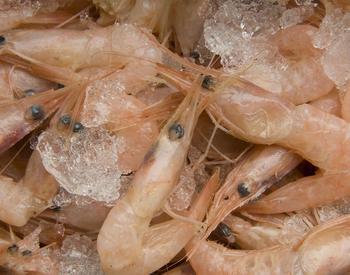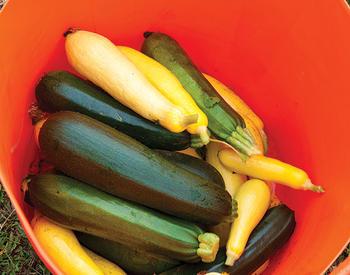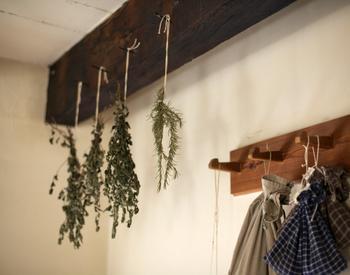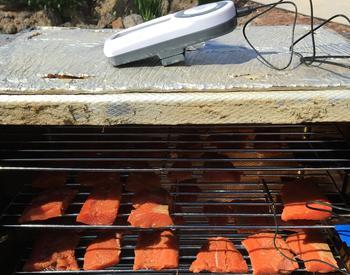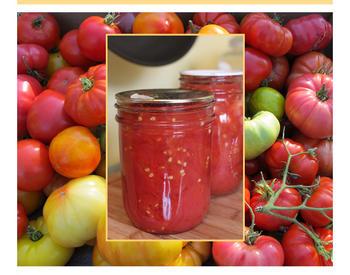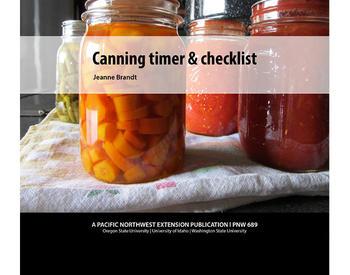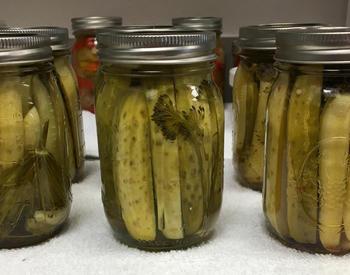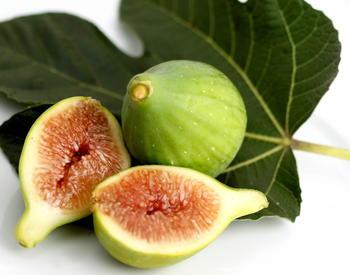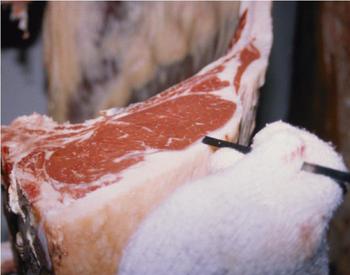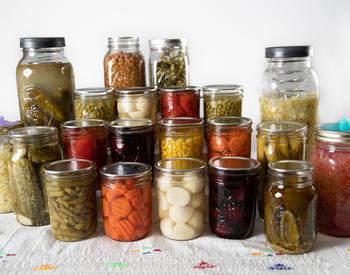Download this publication as a PDF
Many varieties of pears are grown in Oregon. Bartlett, Bosc, and Seckel can well, however Anjou, Comice, Nelis and Forelle may also be preserved, depending on the end product.
It is important to harvest pears at the correct time. Pick them when they are mature in size but not yet fully ripe. If picked too soon, they will shrivel in storage and will lack flavor. If picked when overmature, they will be coarse and grainy in texture, very soft, and often rotten on the inside.
Commercial orchards use a pressure tester to tell when pears are ready to pick. Some county Extension offices have pressure testers and are willing to test the pears. If harvesting your own trees, count the days from bloom to harvest. Winter pears such as Anjou, Comice and Bosc will need a period of cool storage (35-40oF.) to ripen correctly (Anjou, 45-60 days; Bosc, 45 days; Comice, 30 days). Pears purchased from commercial packing houses should be ready to ripen.
Picked pears should be ripened in a cool place (60-70oF). Not all pears will ripen at the same time but inspect them daily. Pears are ripe when the ground color changes, then flesh near the stem end yields to gentle pressure and there is a pear “smell.” Use immediately or store in the refrigerator until ready to use. Pears to be canned should be firmer than for eating fresh. Very soft pears can be used in fruit butters, fruit leathers or pear sauce.
Each pear variety has an identifiable shape, color, and unique flavor of its own. Learn to identify and appreciate each for its particular character and taste. Many of the common varieties sometimes develop red skins, which contributes to eye appeal but does not change the flavor.
Pears are best canned, dried, and made into butters. They also make good relishes and chutneys. Freezing fresh pears is generally not recommended. Cooked pears can be frozen with limited success.
Note: Asian pears, also called apple pears or Oriental pears, are actually a different tree fruit and must be acidified before canning. See Canning Asian Pears (SP 50-694) for instructions.
Canning
It will take 2-3 pounds of pears to fill a 1 quart jar. One bushel (50 lbs.) will yield 20-25 quarts.
Wash pears, peel, cut in halves or quarters and core with a melon baller or metal measuring spoon. To prevent darkening during preparation, see Pretreatment below.
Pretreatment to prevent browning
To prevent darkening mix 1 teaspoon ascorbic acid powder or 3000 mg ascorbic acid (vitamin C) tablets in 1 gallon water. If using tablets, crush thoroughly before adding water. Place prepared fruit in the mixture until needed.
If using a commercial ascorbic acid mixture to prevent darkening follow manufacturer instructions.
Pears canned in sugar syrup will hold their shape, color, and texture better and will have a better pear flavor. Fruit juices such as apple and white grape juice may be used instead of syrup, however, because of the mild flavor of pears, these juices will impart their flavor to the pears. For a 9-pint load, use the following proportions to make syrup:
|
Types of syrup |
Cups water |
Cups sugar |
|
Very light |
6 ½ |
¾ |
|
Light |
5 ¾ |
1 ½ |
|
Medium |
5 ¼ |
2 ¼ |
|
Heavy |
5 |
3 ¼ |
Mix sugar and water together in a large kettle. Bring to a boil.
Hot pack – Drain pears, place into hot syrup and simmer 5 minutes or until pears are heated through. Pack hot pears in jars and cover with boiling syrup, leaving ½ inch headspace. Remove air bubbles by running a plastic spatula or bubbler between the jar and the fruit. Wipe rims and adjust lids. Process pints for 20 minutes in a boiling water canner; quarts 25 minutes. Please see Altitude Adjustment Chart below for processing times above 1,000 feet. After processing, take canner off heat. Remove lid and wait 5 minutes before removing jars.
Hot pack altitude adjustments
Altitude in feet
Pints
Quarts
1,001 to 3,000
25 Minutes
30 Minutes
3,001 to 6,000
30 Minutes
35 Minutes
6,001 & above
35 Minutes
40 Minutes
Raw pack – Drain fruit and pack raw into hot jars, cover with boiling syrup, leaving ½ inch headspace. Remove air bubbles. Wipe rims and adjust lids. Process pints 25 minutes in a boiling water canner; quarts 30 minutes. Please see Altitude Adjustment Chart below for processing times above 1,000 feet. After processing, take canner off heat. Remove lid and wait 5 minutes before removing jars.
Altitude in feet |
Pints |
Quarts |
|
1,001 to 3,000 |
30 Minutes |
35 Minutes |
|
3,001 to 6,000 |
35 Minutes |
40 Minutes |
|
6,001 & above |
40 Minutes |
45 Minutes |
Pear sauce
Prepare pears as for canning. Place cut up pears in a large saucepan and add 1 cup water to prevent sticking. Cook until tender. Press through a food mill or strainer to make sauce. Sweeten if desired. Reheat to simmering (185-210oF.) and pack leaving ½ inch headspace. Process in boiling water canner, 15 minutes for pints and 20 minutes for quarts (see altitude adjustment chart below). After processing, take canner off heat. Remove lid and wait 5 minutes before removing jars.
|
Altitude in feet |
Pints |
Quarts |
|
1,001 to 3,000 |
20 Minutes |
25 Minutes |
|
3,001 to 6,000 |
25 Minutes |
30 Minutes |
|
6,001 & above |
30 Minutes |
35 Minutes |
Pear butter
Pear butter can be made following instructions for fruit butter recipes in Fruit Butters (SP50- 304).
Pear preserves (about 5 half-pint jars)
- 1 ½ cups sugar
- 2 ½ cups water
- 6 medium cored, pared, hard, ripe pears, cut in halves or quarters (about 2 pounds)
- 1 ½ cups sugar
- 1 thinly sliced lemon
Combine 1 ½ cups sugar with the 2 ½ cups water; cook rapidly for 2 minutes. Add pears and boil gently for 15 minutes. Add remaining sugar and lemon stirring until sugar dissolves. Cook rapidly until fruit is clear, about 25 minutes. Cover and let stand 12 to 24 hours in refrigerator.
Sterilize canning jars. Heat fruit and syrup to boiling. Pack fruit into hot jars, leaving ¼-inch headspace. Cook syrup 3 to 5 minutes or longer if too thin. Pour hot syrup over fruit, leaving ¼-inch headspace. Wipe jar rims and adjust lids. Process 5 minutes in a Boiling Water Bath (see altitude adjustments chart next page - altitude adjustment for Pear Preserves from National Center for Home Food Preservation web page).
Note: Small pears may be preserved whole with stem intact; peel pears and wash stem well. For best flavor, Kiefer pear preserves should be stored in a cool, dry place from 3 to 5 weeks after processing before using. A piece of preserved ginger may be added to each jar.
|
Altitude in feet |
Hot pack ½ pints or pints |
|
1,001 to 3,000 |
10 Minutes |
|
3,001 to 6,000 |
10 Minutes |
|
6,001 & above |
15 Minutes |
Source: So Easy to Preserve, 6th Edition (2014) University of Georgia
Spiced pears (about 4 pint jars)
3 ½ pounds medium ripe pears (14-16)
Tie in a spice bag:
- 2 ½ cups granulated sugar 2 teaspoons whole ginger
- 1 ¼ cups white vinegar (5%) 2 tablespoons whole cloves
- 1 cup water 7 sticks cinnamon (3-inch pieces)
Wash, peel, and core pears. Place immediately in a solution of ½ teaspoon ascorbic acid and 2 quarts of water to prevent browning. Combine sugar, vinegar, and 1 cup water; bring to a boil. Add spices tied in a cheesecloth bag. Boil 5 minutes Drain pears and add to syrup. Simmer 5 minutes or until soft but still firm. Remove spice bag.
Pack pears into hot jars, leaving ½-inch headspace. Fill jars to ½ inch of top with boiling hot syrup. Remove air bubbles. Wipe jar rims. Process 15 minutes in Boiling Water Bath (see Altitude Adjustment chart below).
|
Altitude in feet |
Hot pack, pints |
|
1,001 to 3,000 |
20 Minutes |
|
3,001 to 6,000 |
20 Minutes |
|
6,001 & above |
25 Minutes |
Source: So Easy to Preserve, 6th Edition (2014) University of Georgia
Drying pears
Pears are excellent dried. It is best to dry fully ripe pears, rather than soft, mushy ones. Preparation: Wash and peel pears. (Pear skin tends to become tough and grainy when dried.) Cut into ¼ to ½ inch slices. Pears tend to darken quickly, so pretreatment (directions above) is recommended for a lighter product and longer storage.
Drain well and spread in a thin layer on drying trays. Dry until pliable and leather in the sun, oven, or dehydrator at 130oF to 140oF. Dried pears are great eaten as snacks or can be slightly plumped in water and used in breads, chutney, cookies, salads, fritters or granola.
Leathers or fruit rolls
Pear leather is a bit grainy and tasteless by itself. However, it is great mixed with other fruits since it adds body to the puree and mellows the flavors. Try mixing pears with berries, apricots, peaches and plums.
